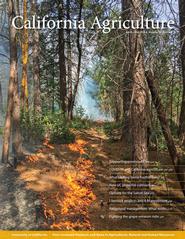All Issues

A prescribed fire on private land in El Dorado County, February 2020. The objective of this burn was to reduce fire hazard in the wildland–urban interface on the Georgetown Divide. The area had been high-grade logged 15 years earlier and was pre-commercially thinned two years earlier. Photo by Rob York.
Volume 74, Number 2
News and opinion
The weather last fall was unusually favorable for private landowners to carry out prescribed burns to reduce wildfire hazard. Burn permits, however, made burning unnecessarily difficult. Safe and effective prescribed burns can benefit from changes in permitting.
COVID-19 may accelerate trends in California agriculture toward mechanization and the use of guest-worker programs.
An interview with UC Cooperative Extension experts about the effect of the coronavirus pandemic on food production.
UC Cooperative Extension and landowners join forces to probe possible causes of mysterious blue oak mortality in the Sierra foothills.





